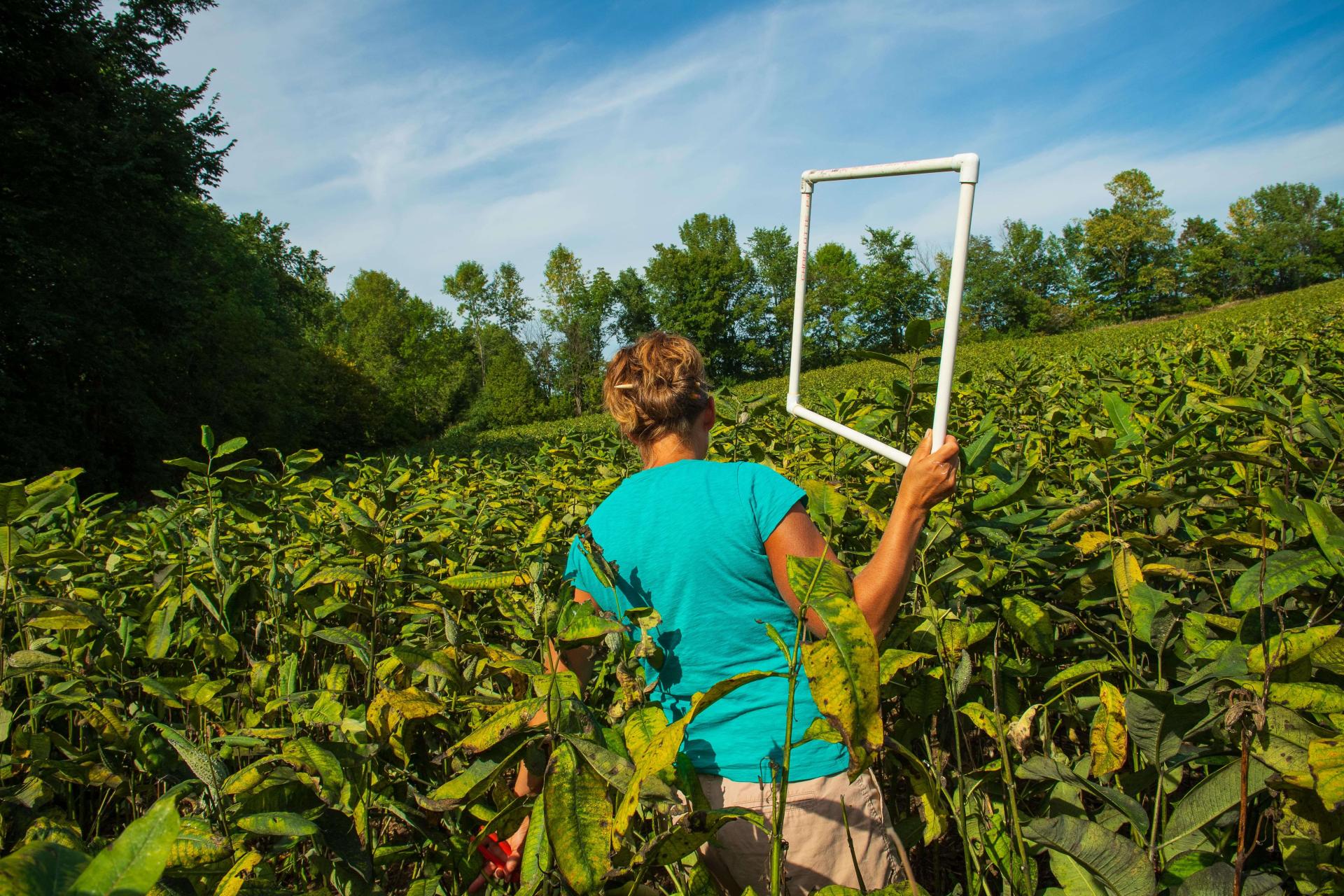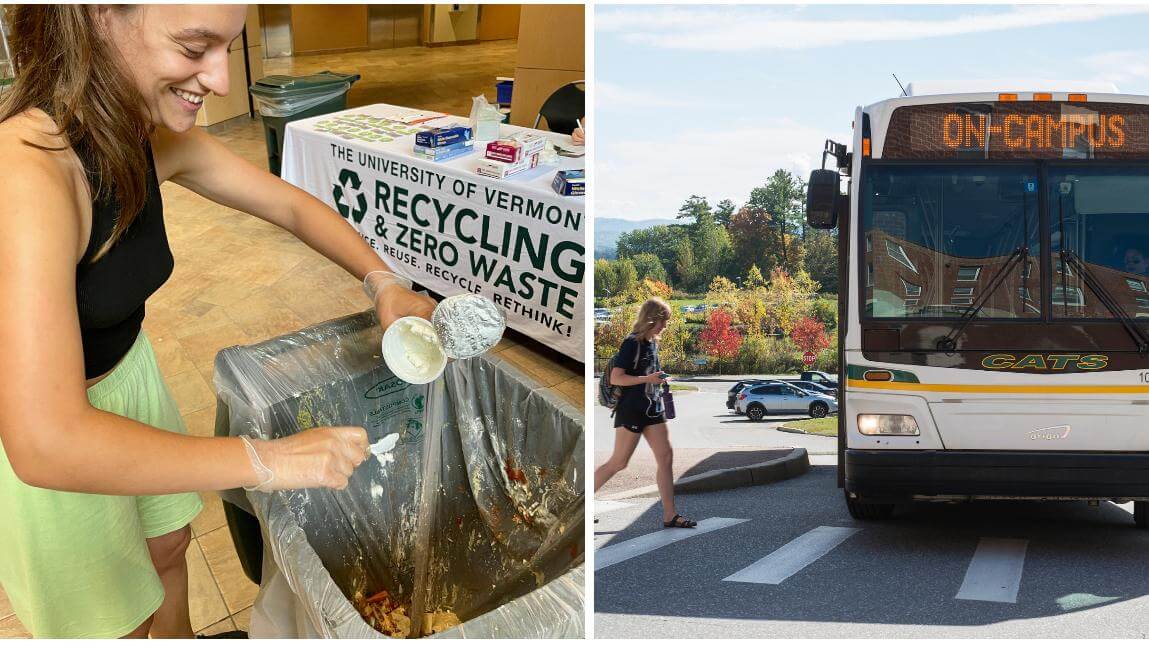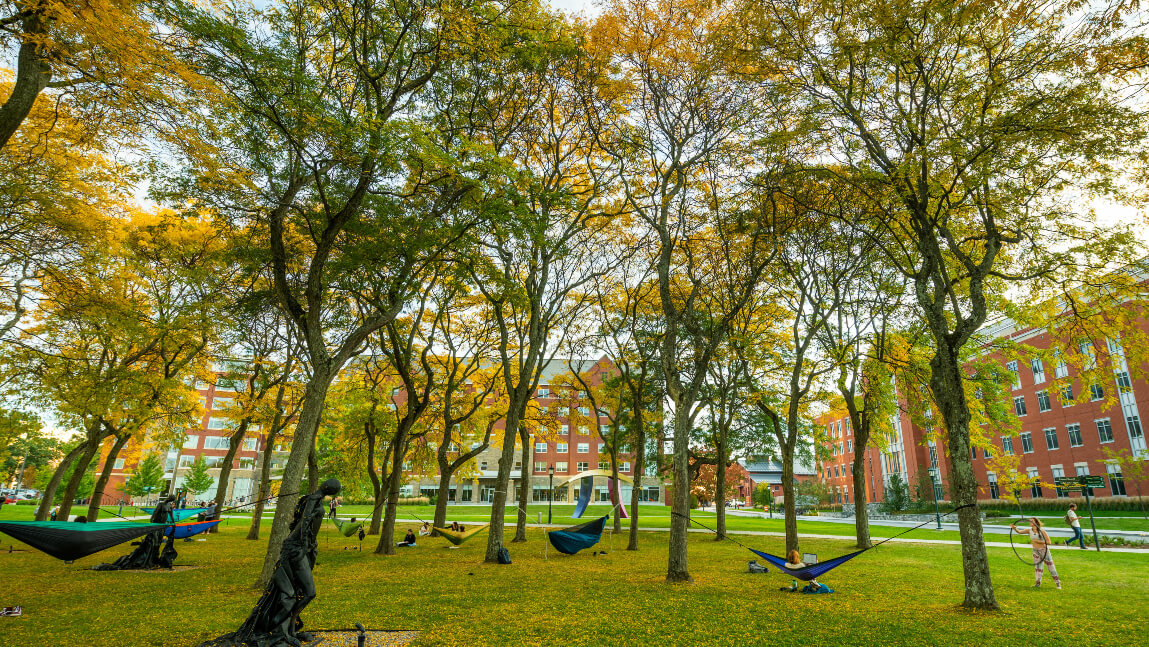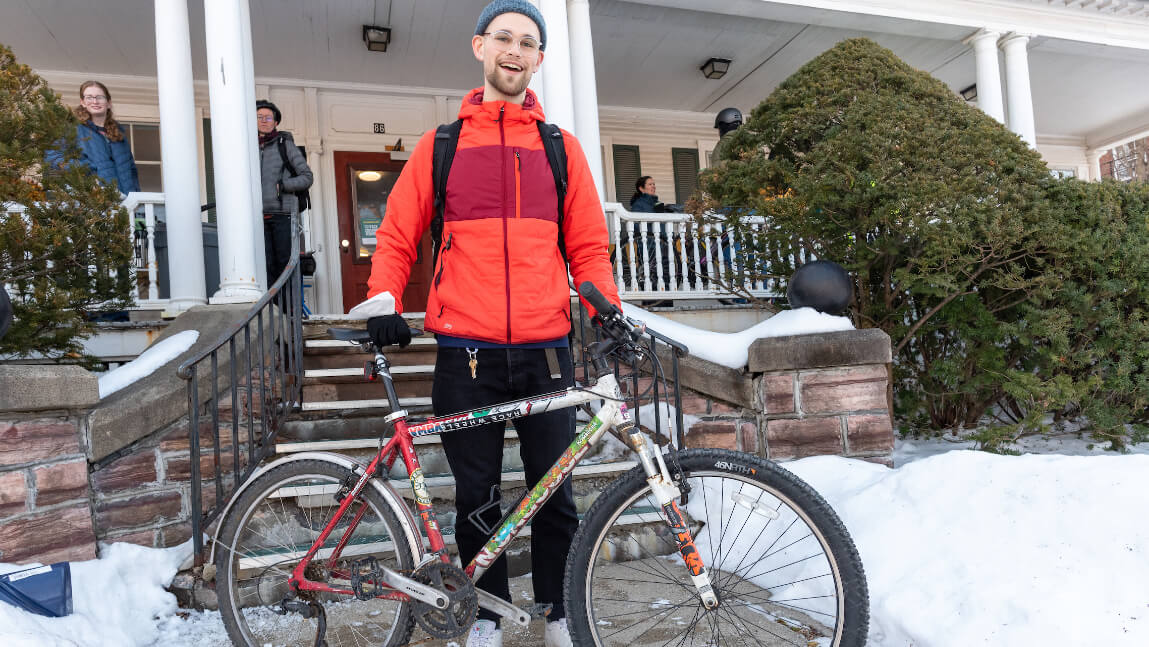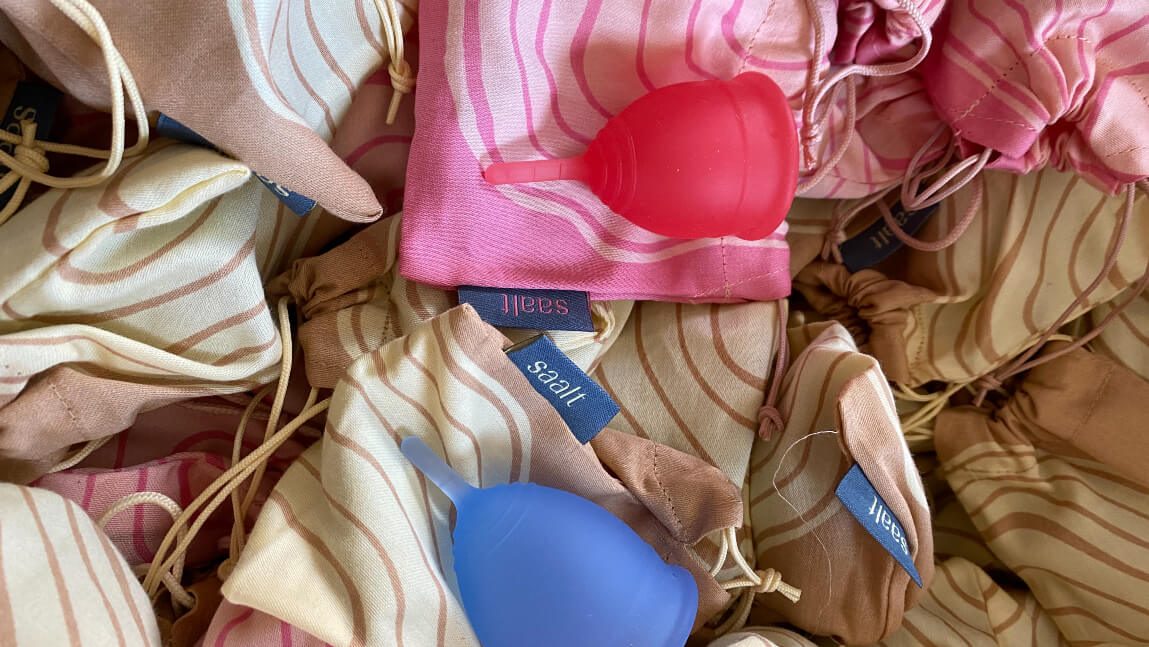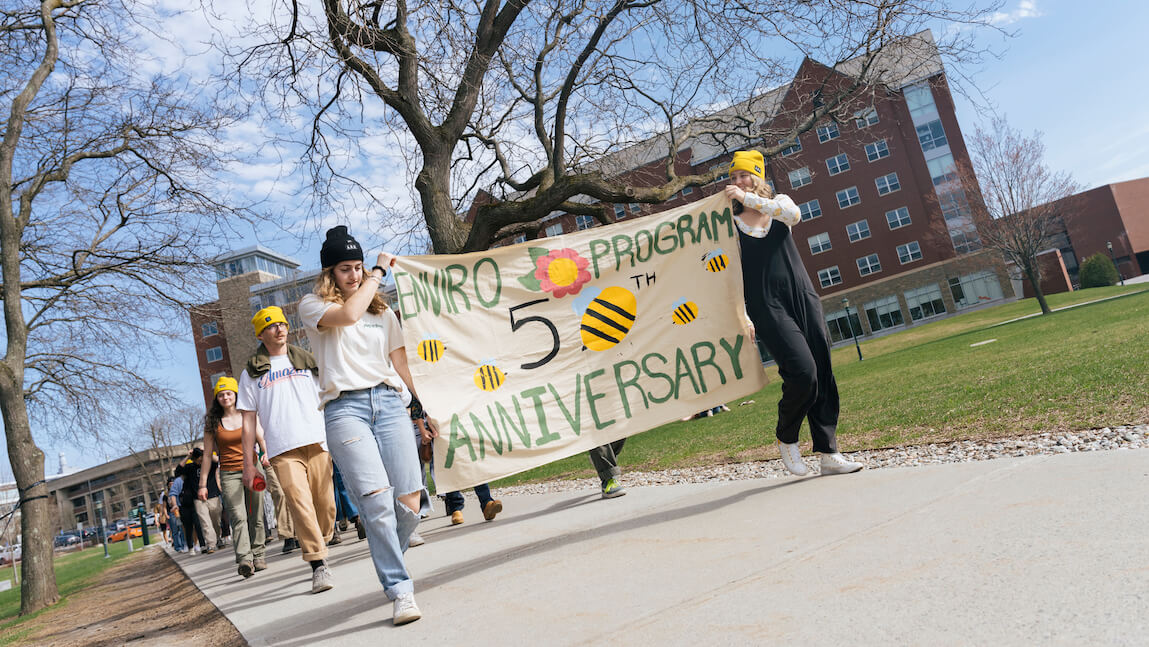The Davis Center was built with this as one of its core values. From the get-go, we were built with the goal of obtaining Leadership in Energy and Environmental Design (LEED®) certification in green design. Therefore, every beam, window, or supply purchased during the construction process was cause for consideration — UVM was committed to leaving the smallest environmental footprint possible when building the DC.
And it worked! When the Davis Center opened its doors in 2007, it became the first student center in the U.S. to earn LEED Gold Certification for new construction. Moving forward, the University of Vermont has sought official certification for all new and major campus renovation and building construction projects.
Green Design and Building
LEED® Gold Certification
The Davis Center has recently been awarded LEED® Gold certification by the U.S. Green Building Council. LEED is an acronym for Leadership in Energy and Environmental Design and provides design guidelines that aim to reduce energy usage, water consumption, solid waste, air pollution and building toxicity. In 2005, UVM appointed a green building coordinator and adopted a green building policy whereby all new construction and major renovation projects on campus must use LEED guidelines.
In 2007, the policy was upgraded to require achieving a minimum level of LEED Silver equivalent. Since the policy has been put into effect, UVM has sought official certification for all new and major renovation building construction projects.
More about the LEED process — official LEED Checklist (PDF) and USGBC Review (PDF)
More about the University's planning — green building policy statement (PDF)
Energy use
The Davis Center uses four energy commodities: electricity for lighting and plug-in equipment (like computers), steam for heating, chilled water for cooling, and natural gas for cooking and fireplaces. Overall, the Davis Center is expected to use 52% less energy than a conventional building of the same size (186,000 square feet). The UVM Energy Management Office oversees planning, implementation and accountability measures for the building's amazing energy-saving technologies.
Learn more about the systems:
Electricity
- All of the electricity used at the Davis Center is purchased from Burlington Electric Department, a local public utility that buys from a fairly clean mix of sources with over 60% from renewable sources.
- The building was designed to use 31% less electricity for lighting than a conventional building of the same size (186,000 square feet).
- Windows and sky-lights in the building maximize natural light and thus minimize the need for electric light during the day. Computerized lighting control systems automatically adjust light levels and shut off lights when rooms are unoccupied.
- Ventilation systems throughout the building are equipped with energy conservation motors. The kitchens have special Intelli-Hood™ exhaust fans that automatically slow down when cooking demands are low and speed up only when cooking volume increases — this saves electricity and increases the life of the fans.
- Want more detail? Contact the UVM Energy Management Office to learn more about specific electricity-saving technologies around the building.
Heating
- The steam used to heat the Davis Center is generated at UVM's Central Heating and Cooling Plant and the fuel mix used in the plant's boilers is primarily natural gas (approximately 95% in 2007) and some fuel oil (approximately 5% in 2007).
- Rooms in the Davis Center are very smart! Carbon dioxide sensors, which detect the presence of people by detecting the carbon dioxide in their breath, signal a room's heating system to shut off when no one is using the room. When somebody opens a window, computerized sensors send a signal to shut off the heating.
- The heat recovery ventilation system on the roof captures heat from air as it is exhausted from the building. This captured heat is used to warm cold air coming into the building so that steam energy can be conserved.
- The building was designed to use 59% less energy for heating and cooling than a conventional building of comparable size.
Cooling
- The chilled water used to cool the Davis Center is generated at UVM's Central Heating and Cooling Plant using energy from excess steam. The fuel mix used in the plant's boilers in the summer is 100% natural gas, a very efficient fuel.
- Rooms in the Davis Center are very smart! Carbon dioxide sensors, which detect the presence of people by detecting the carbon dioxide in their breath, signal a room's air-conditioning to shut off when no one is using the room. When somebody opens a window, computerized sensors send a signal to shut off the cooling.
- On warm days, the heat recovery ventilation system on the roof uses the cool exhaust air to pre-cool the warm intake air so energy can be conserved.
- The building was designed to use 59% less energy for heating and cooling than a conventional building of comparable size.
Natural gas
- The natural gas that is burned at the Davis Center for cooking in the kitchens and fireplaces in the lounges is purchased from Vermont Gas Systems, Inc.. The gas comes from Canada by pipeline.
Natural gas for heating
- The UVM Energy Management Office has submitted for $18,000 in Vermont Gas Systems rebates based on tight insulation and efficient ventilation systems in Davis that will suppress demand for steam-heat from natural gas burned at the Central Heating and Cooling Plant.
Equipment
- The public computers in Davis are all Apple iMacs©. They use energy very efficiently and also conserve material resources since the screen display and CPU are contained in the monitor.
- Office, kitchen and cleaning equipment in the building are ENERGY STAR® qualified, which means that they are energy-efficient choices.
Renewables
- Electricity used in the Davis Center is purchased from the Burlington Electric Department (BED), which buys from at least 60% renewable sources, primarily from wood chips burned at the McNeil Generating Station in Burlington.
- UVM's 10 kW wind turbine is visible from the oval in front of Davis. The electricity generated by this large residential-size turbine returns to the electrical grid to offset the electrical consumption of exterior lights.
- Solar panels on the roof of UVM's Central Heating and Cooling Plant generate electricity that is used to help light the Plant. Since the building's steam and chilled-water come from the Plant, the UVM residential-sized Solar Energy Project is indirectly contributing to Davis Center operations.
Carbon footprint
- As part of the Association of American College and University Presidents' Climate Commitment, the University will publish an inventory of Greenhouse Gas Emissions at UVM from 1990-2006. The Davis Center provides a case-study to illustrate first steps in how emissions from building systems can be reduced.
Water use
The Davis Center is equipped with innovative water-saving technologies. The building was designed to use 41% less water than a conventional building of comparable size (186,000 square feet). In addition, the green roof over the loading dock helps to manage stormwater runoff.
Learn more about what happens to water in and around the building:
Stormwater runoff
- The driveway to the loading dock on the first floor has a special feature that keeps it free of ice in the winter without the use of salt. Radiant tubing under the driveway transfers heat from hot water to the driveway to prevent ice formation. The tubing turns on automatically when sensors detect moisture at low temperatures and turns off when conditions are dry. Stormwater runoff from the driveway is cleaner and less harmful to Lake Champlain because the radiant tubing eliminates the need for road salt.
- Most of the land around the Davis Center is green space that allows stormwater to filter down into it instead of running off into storm drains that carry water to Lake Champlain. The green roof is a good example of how impervious surfaces have been kept to a minimum around the building. Organic pollutants contained in the stormwater are used as nutrients for the plants around Davis instead of going into the Lake.
Bathrooms
- Water is conserved by waterless urinals and water-efficient toilets that use 1.6 gallons per flush.
- All of the bathroom sinks have automatic faucets that dispense warm water at a rate of 0.5 gallons per minute when they sense a user's hands under them, and that turn off when no one is using them.
- The showers in the gender-neutral bathrooms on each floor have low-flow shower-heads that use 1.5 gallons of water per minute whereas conventional shower-heads use 2.5 gallons of water per minute.
Wastewater treatment
- Wastewater from the Davis Center drains through city pipes to the Burlington Wastewater Treatment Plant on Lavalley Lane near the lake. It is important not to dispose of any inappropriate substances in sinks and toilets because after treatment at the wastewater plant, this water is discharged into Lake Champlain.
Cleaning
- The custodial staff keeps building surfaces clean with long-lasting, reusable microfiber cloths and microfiber mops. Microfiber requires less water and chemical cleaning agents to pick up dirt and spills than conventional options, and it requires less time in the dryer than towels, thus saving both water and electricity. Cloths are color-coded by use: red for bathrooms, yellow and blue for general use, and green for windows. Before they are reused, cloths are washed and dried by color group in the building's energy-efficient washer and dryer.
- The front-loading washing machine in Davis has a load-size sensing indicator that allows it to automatically adjust the water level to match the size of the load so that no water is wasted.
- Davis has a fleet of four carpet-cleaning machines that were chosen for their water-conservation features and energy-efficient rechargeable batteries.
Land use
In accordance with the 2006 Campus Master Plan, which officially declared the university's intention to become "a model for environmental sustainability," the outdoor landscape of the Davis Center features native plants, pedestrian and multi-use paths, and innovative ways to collect and recycle stormwater. UVM has also chosen not to irrigate any plantings on campus, except on the University Green. Not to mention, the Davis Center actually added green space to UVM's campus (the majority of the building was constructed over an old parking lot).
Get the facts on:
Landscaping
- The grounds around Davis are planted with drought-resistant grasses and shrubs that are native to Vermont. This eliminates the need to irrigate and strengthens the connection between the campus community and local nature.
- Outdoor seating, pathways, and a performance space invite people in the Davis Center to value, respect and make use of campus green space.
Green roof
- The 18,000 square foot green roof over the loading dock is planted with 11,900 square feet of a variety of drought-resistant grasses. Around the edges, tall ornamental grasses give the roof a garden feel without the need for watering: Flame Grass (Miscanthus purpurescens), Blue Oat Grass (Helictotrichon 'Saphirsprudel'), Red Switch Grass (Panicum virgatum 'Rostrahlbusch'), Blue Switch Grass (Panicum virgatum 'Heavy Metal'), and Northern Sea Oats (Chasmanthium latifolium). In the center of the roof, a lawn of specially blended Fescues (Festuca sp.) and Ryegrasses (Lolium sp.) survives drought without irrigation: Creeping Red Fescue, Spartan Hard Fescue, Azay Sheep's Fescue, Fiesta Perennial Rye and Annual Rye Grass.
- The green roof absorbs stormwater and uses the nutrients it contains to nourish the plants. Without the green roof, this stormwater would run off and carry salts and dissolved chemical nutrients into Lake Champlain, polluting it and contributing to unwanted algae blooms.
- The layer of soil on the green roof varies from 6-21 inches deep with an average depth of 12-14 inches. It can hold up to 80 lbs. of weight per cubic foot including the soil itself, the grasses and stormwater. If too much water falls onto the roof at once, the excess runs into roof drains located below the soil and at the level of the grass and paving. However, since the roof is designed to absorb between 12 and 42 lbs. of water per cubic foot, only very large storms overload it.
- The roof is not designed for growing vegetables or other plants with heavy nutrient and water requirements. Large storm events have the potential to wash some nutrients from the roof down the drains so adding compost or fertilizer to the roof could result in wasteful pollution of Lake Champlain.
Transportation
- With 100 outdoor spaces for bicycles and showers on every floor (in the gender-neutral bathrooms), the Davis Center makes it easier for people to walk, run or bike to campus.
- Main Street is one of Burlington's busiest vehicle traffic areas, but thanks to the corridor that extends from the 1st floor of the Davis Center to the other side of Main Street, there is no longer any need to try to cross in front of cars.
- The Campus Area Transportation System (CATS) shuttle buses pick up and drop off riders in front of the Davis Center oval near the building's third floor entrance. These buses, which run on compressed natural gas and/or biodiesel, make it easy to get around campus.
- Local public transportation from Chittenden County Transportation Authority (CCTA) picks up on Main Street right outside of the Davis Center. Riding the CCTA buses, which run on biodiesel, is free for students, faculty and staff with an active UVM ID card.
Materials
The Davis Center was constructed with a commitment and attention to the local economy and great environmental consideration. The building was designed to incorporate slate and wood from the local landscape. As much as possible, local labor, and manufacturing were also relied upon during construction. Portions of the former Carrigan Building were recycled into the building content of Davis. Recycled content was a priority for furniture and other interior aspects, as were low-VOC emitting materials that ensure a healthy indoor environment.
Building green is only a part of the story — environmentally preferable office supplies, food, and other materials that cycle into the building, as well as responsible management of solid wastes that leave the building, are also an important part of the Davis Center's effort to protect the environment and strengthen the local economy.
Check out photos from the construction of the Davis Center (password: daviscenter)!
Learn more about the materials:
Local
- Local materials, sourced or manufactured within a 500-mile radius of UVM, comprise 66% of the building, funneling close to $6.4 million into the local economy for materials alone. This building used three times the minimum LEED requirement for local building materials.
- Local labor was used to install concrete, glass and drywall, to manufacture and lay bricks, to design and build the clock in the atrium and much more. Well over 60,000 person-hours of labor went into constructing the building and the economic benefits of this work stayed in Vermont.
- Using local materials to create the building dramatically reduced transportation-related pollution and carbon emissions during the construction phase.
- Most of the wood used for indoor fixtures and furniture was grown locally in a sustainable manner. Much of it is certified by the Forest Stewardship Council(c), also termed FSC-certified(c), to guarantee that it was harvested in a way that protects forests.
Recycled
- 92% of the construction waste, by weight, from building the Davis Center was recycled.
- All new materials used in the building have at least 5% recycled content.
Product flow (what comes in)
- Disposable paper and plastic products
- Paper packaging and take-out containers for the food services at Davis are chosen with environmental responsibility in mind. If you forget to bring your own mug, you can get your coffee to go in a compostable Ecotainer ™ cup.
- You won't find any paper towels in the bathrooms — they have high-efficiency hand dryers instead. Paper towels are also used sparingly by the building's custodial staff.
- Office Supplies
- All of the paper used for copying at the Davis Center is 100% post-consumer recycled and chlorine-free. In fact, UVM has a campus-wide environmental policy for copier paper purchasing.
- Food
- Local foods are an important part of the Davis Center. University Dining Services is working diligently to make connections with local farms and educate diners about Vermont's food economy by partnering with the Vermont Fresh Network, Black River Produce, Arethusa Farms, Champlain Orchards and other local food initiatives. New World Tortilla and Ben and Jerry's Ice Cream are also housed inside the Davis Center and are Vermont companies that are committed to environmentally-responsible ingredients.
- Most of the coffee and tea that is provided at Davis is either certified organic, Fair Trade certified™, or both. Both are purchased from local companies with strong environmental ethics: Green Mountain Coffee Roasters and Vermont Artisan Coffee & Tea Company.
- Cleaning Supplies
- The indoor environment is kept healthy and toxin-free because more than 90% of the cleaning supplies used in Davis meet environmentally sustainable standards as specified by the US Green Building Council. Toxin-free wastewater also means a cleaner, healthier Lake Champlain.
- For regular jobs in Davis, the custodial staff uses an all-purpose cleaner from EnvirOxand for tougher cleaning jobs they usually rely on an environmentally safe degreaser called The Greasinator™, which is Green Seal Certified™, or a low-toxicity mineral cleaner, called Mineral Shock™.
- Environmentally Responsible Products at the Bookstore
- Compact Fluorescent Lightbulbs (CFLs) are available for sale in the bookstore. These bulbs use 66- 75% less energy than equivalent incandescent bulbs and last up to 6-10 times as long.
- Choose recycled paper notebooks for all of your classes. The bookstore sells a line of notebooks made with 30% post-consumer waste.
- Vermont Products
- A variety of products that support Vermont entrepreneurs are also available from other stores in the DC. CAT Pause convenience store carries an array of items ranging from frozen meals to luxurious body balms. The bookstore and the adjacent Henderson's Cafe carry maple products and chocolates, and feature books and artwork by Vermont writers and artists.
Waste stream (what goes out)
- Conserving Disposables
- The Marketplace and Henderson's Cafe give discounts on coffee and fountain drinks when you buy them in your own reusable mug. In fact, all of the University Dining Services venues on campus support the use of reusable mugs to reduce waste on campus.
- Publications of the Davis Center and the Office of Student Life are planned and printed with the environment in mind to minimize paper consumption, ink usage and energy requirements.
- Recycling
- Throughout the building you will find built-in recycling collection stations for paper and for bottles and cans. Each day the recyclables are picked up by UVM's Recycling Teamand later transported to the Material Recovery Facility in Williston.
- Used cooking oil and grease from the kitchens is collected regularly and hauled to Winooski where it is converted to bio-diesel fuel by a local company who sells it to consumers for heating, transportation, farming, maple-sugaring and more.
- Food and supplies packaged on wooden pallets are delivered to the Davis Center regularly. The pallets are picked up from the loading dock and taken to the McNeil Generating Station in Burlington where they are burned to generate electricity for Burlington Electric Department, from which the Davis Center buys its electricity.
- Composting
- As a result of a partnership between University Dining Services and the Intervale Center in Burlington, food scraps and coffee grounds from the Davis Center are collected each day and taken to the Intervale where they are used to produce Intervale Compost, which is sold to farms and gardens in the area.
- Students can bring food scraps and compostable waste collected in the dorms to thebuilt-in compost collection space in the Davis Center's second floor dining area, next to the dish return area.
- Landfill Trash
- Solid waste collected in trash cans in the Davis Center is taken to a regional Vermont landfill near the Canadian border that uses a methane gas capture system to reduce greenhouse gas emissions. To learn more about how UVM is working to make trash pick up as efficient as possible, visit UVM Recycling and Waste Management.
- Students are holding the Davis Center accountable for keeping trash to a minimum. A few months after the building opened, the UVM Eco-Reps and the Vermont Student Environmental Program conducted a waste sort to see what was in the trash from the dining areas in Davis. In 680.4 pounds of trash, the students found that less than 2% was disposable cups and less than 9% was recyclable cans, bottles and paper.
Conscious of materials
- 5% recycled content in new materials.
- 65% of building materials manufactured locally (within a 500 mile radius). How? Easy — our Slate comes from Fair Haven, VT; maple from Shelburne, VT; bricks from East Highgate, VT; soil on the green roof is from Burlington's Intervale.
- Low–emitting materials (carpet, paints and sealants) in the building's interior make for a healthy climate.
- We even received a Forest Stewardship Council certified wood credit for wood used in the building.
Advocating a green lifestyle
- With over 100 bicycle spaces (which exceed the LEED requirement), the Davis Center promotes alternative forms of transportation. Walk, run, skate or bike to campus — we've got showers on every floor to make your commute easier.
- No campus green space was consumed in constructing the Davis Center, rather we added green space. The Davis Center was constructed over a parking lot and Carrigan Building.
- Our partners help us keep food and ingredients in our dining areas local. UVM Dining's commitment to the Vermont Fresh Network and partnerships with local food providers such as Arethusa Farms, the Intervale Center, and more.
- Because the mass of the building faces south, we rely on a large supply of natural light to keep electricity use to a minimum.
- We have built–in recycling collection spaces and composting in our building's dining operations.
Saving resources
- We estimate 52% savings in electricity, heating and cooling compared to a non–LEED building of our size (186,000 square feet). How? With A computerized energy management system including a lighting control system and carbon dioxide sensors that shut off heating and cooling systems when rooms are not in use.
- We estimate a 41% reduction in water use compared to a non–LEED building of our size. Features like we have flush-less urinals and automatic faucets help us meet this goal.
- During construction 92.08% of construction waste was diverted from a landfill by reusing and recycling it.
- 94% of the pre-existing Carrigan Building (measured by weight) was reused or recycled during demolition. The building rubble was crushed and used as underlay for paths around the Davis Center and for local roads.
- Not only our green roof adds more green space to the building's environs (not to mention helps with insulation), but it also manages and reduces stormwater run–off; plus the radiant heat system for the loading dock below the green roof eliminates the need for salt and other ice melts.
Bottled-water free campus
In January 2013, UVM officially became one of the first institutions nationwide to end the sale of bottled water on campus and mandated that one-third of drinks offered in vending machines be healthy options. The decision marks the advent of a long-awaited systematic sustainable beverage policy after years of lobbying by students and the greater campus community — spearheaded by the Vermont Student Environmental Program (VSTEP), a student run, non-profit organization created in 1988 to expand UVM’s recycling program and address environmental issues on Vermont campuses.
Because Burlington's tap water is safe and clean, the University can rely on cool, plain, unfiltered tap water to hydrate campus. Plumbers have installed bottle fillers on more than 75 of the 215 fountains on campus, and people are already used to filling their own bottles. More bottled fillers are coming.
In addition to all the places you can find some great H20 around campus, the Davis Center alone is home to a total of 8 water fountains (2 on each floor), 4 of which are outfitted with water-bottle fillers to ensure students, staff, and building visitors are healthy, happy, and adequately hydrated.
OK, but what does this all mean?
This all means the Davis Center is a building you can feel good about — maybe even proud of. UVM’s green mission is something that our building demonstrates every day. We hope you’ll stop by, hang out, and know that you’re a part of something bigger than a building!
